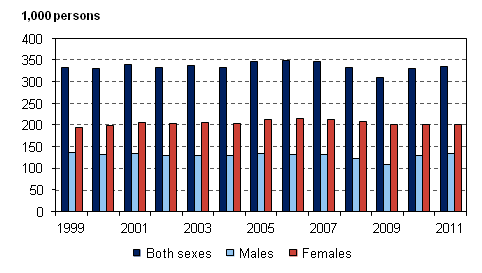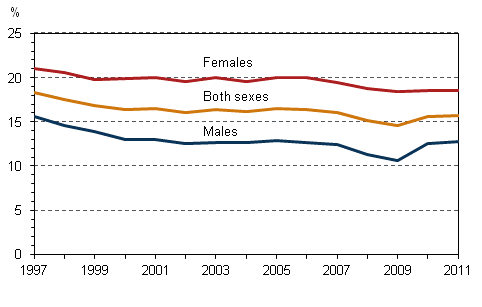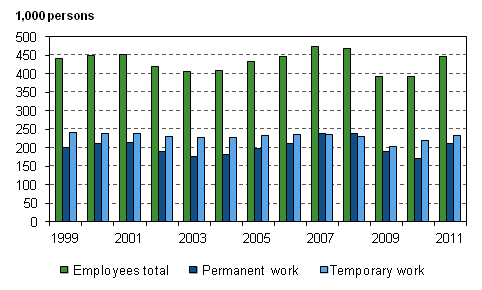4 Number of employees whose present work has continued less than one year grew in 2011
4.1 Temporary employment contracts more usual among women than men
In 2011, the average number of employees in Finland was 2,143,000, which was 23,000 higher than in 2010. The number of employees with permanent employment contracts grew by 17,000 and that of employees with temporary contracts by 6,000. Altogether 336,000 employees held temporary employment contracts (Figure 10). Temporary employment continues to be more widespread among women than men. In 2011, 202,000 of all temporary employees were women and 135,000 men.
Figure 10. Number of temporary employees aged 15 to 74 by sex in 1999–2011

Eighty-four per cent of all employees’ employment contracts were permanent and 16 per cent temporary in 2011. The shares were unchanged from the previous year. The share of temporary employees among all employees was still below the long-term average. Among female employees, the share of temporary employees was 19 per cent and among male employees 13 per cent. The number and share of temporary employment contracts grew slightly among male employees in 2011. Among female employees, they remained on level with the year before (Figure 11).
Figure 11. Share of temporary employees of all employees aged 15 to 74 by sex in 1997–2011, %

Compared to the respective period of the previous year, the number of temporary employment contracts went up most in the first quarter of 2011. By contrast, the number of temporary employment contracts decreased slightly during the last quarter of the year.
4.2 Two out of three temporary employees would want a permanent job
To an employee, temporary employment can be either a desired or involuntary form of employment. Approximately 27 per cent of temporary employees did not want a permanent job in 2011. The majority of them were aged between 15 and 24. Summer workers are a typical group of persons working voluntarily in temporary jobs.
However, a more common reason for working in a temporary employment relationship is that permanent work cannot be found. In 2011, the lack of permanent work was the reason why around 63 per cent of temporary employees worked in temporary jobs. The share of persons working involuntarily in temporary jobs among all temporary employees remained almost unchanged from 2010 to 2011.
In 2011, there were 208,000 temporary employees on the labour market who had not found a permanent job even though they would have wanted one. Of them, 129,000 were women and 79,000 men. Involuntary working under temporary contracts increases with age.
4.3 Number of employees whose present work has continued less than one year grew in 2011
The number of employees whose present work has continued less than one year grew clearly from 2010 to 2011. There were 446,000 such new employment contracts in 2011, or some 53,000 more than in 2010 (Figure 12).
Figure 12. Employees whose present work has continued less than one year aged 15 to 74 in 1999–2011

Fifty-two per cent of such new employment contracts were temporary. The share was one percentage point smaller than in 2010 and four percentage points smaller than in 2009.
There has been a clear difference between women and men in whether a new employment contract is temporary or permanent. The situation has remained very similar since 1997 when a comparable time series begins. In 2011, 58 per cent of women’s and 46 per cent of men’s new employment contracts were temporary.
4.4 Only one per cent of employees did temporary agency work
Temporary agency work refers to an employment relationship in which an employee works via an enterprise that intermediates or hires labour force. Data on temporary agency work have been collected in the Labour Force Survey since 2008. In 2011, the average number of persons doing temporary agency work was 28,000, or about the same as in 2010. Approximately one-half of the temporary agency workers were women.
Temporary agency workers only made up one per cent or so of all employees in 2011. Thus, doing temporary agency work is quite a marginal form of working on the Finnish labour market. Temporary agency work is mainly done by young people; around five per cent of 15 to 24-year-old employees were doing it.
Temporary agency workers are employed by several industries. Their use is commonest in wholesale and retail trade, hotel and restaurant activities, and in manufacturing. Each of these industries employed a couple of thousand temporary agency workers.
Source: Labour Force Survey 2011. Statistics Finland
Inquiries: Kirsi Toivonen 09 1734 3535, Olga Kambur 09 1734 3565, Tarja Nieminen 09 1734 3561, tyovoimatutkimus@stat.fi
Director in charge: Riitta Harala
Updated 9.3.2012
Official Statistics of Finland (OSF):
Labour force survey [e-publication].
ISSN=1798-7857. Employment and unemployment in 2011 2011,
4 Number of employees whose present work has continued less than one year grew in 2011
. Helsinki: Statistics Finland [referred: 2.1.2026].
Access method: http://stat.fi/til/tyti/2011/13/tyti_2011_13_2012-03-09_kat_004_en.html

